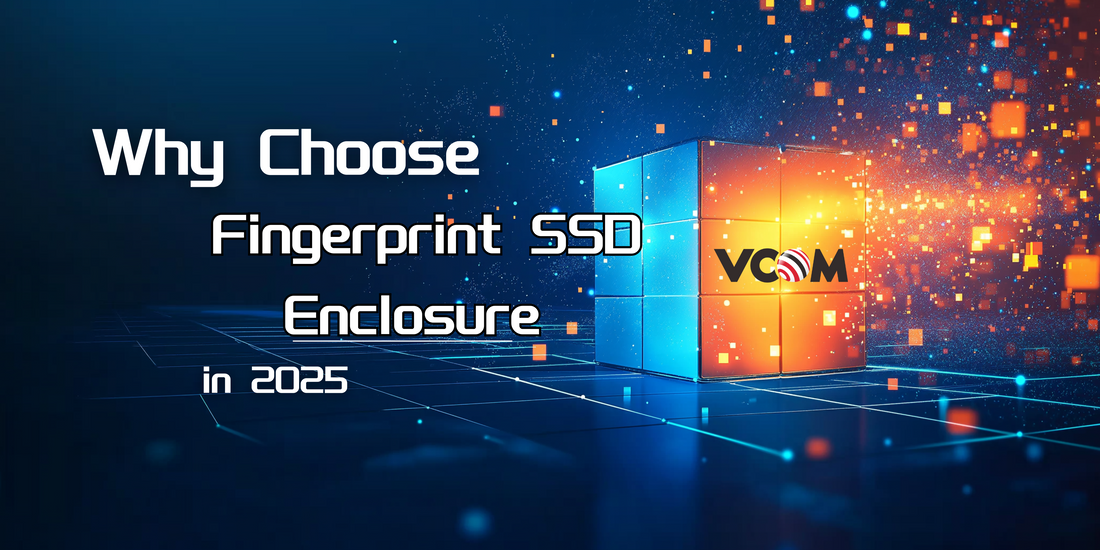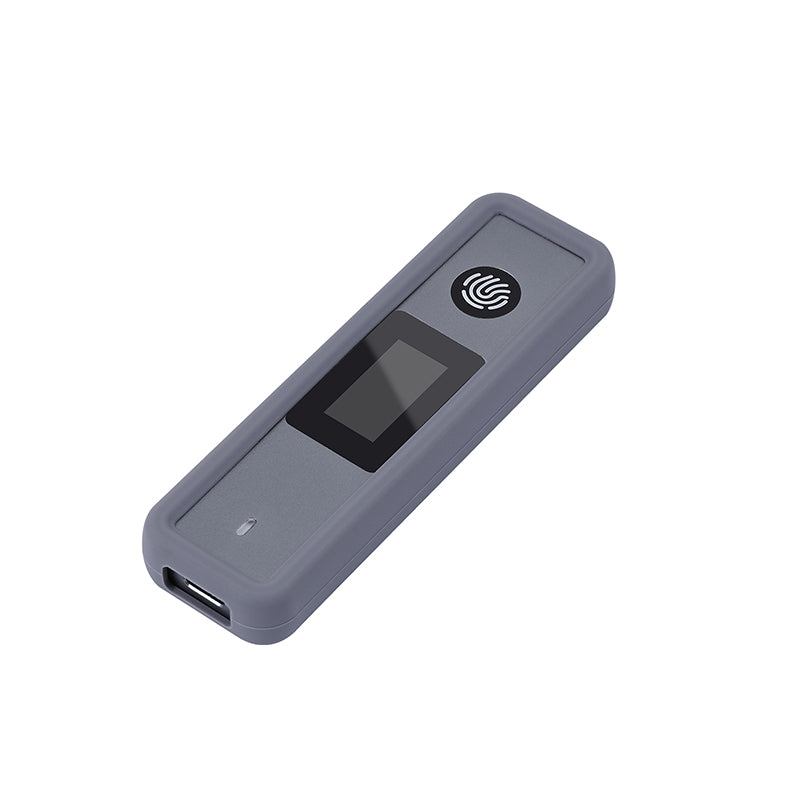
Share
Why Choose a Fingerprint SSD Enclosure for Data Security in 2025
Portable storage devices have become a cornerstone of modern work and digital life. From freelancers carrying projects between home and co-working spaces to IT teams managing sensitive customer data, external SSDs are a fast, flexible way to move large files. But with mobility comes risk. Lost drives, theft, or unauthorized access can compromise entire datasets in minutes.
That’s why fingerprint SSD enclosures—which combine biometric authentication with hardware-level security—are emerging as a practical solution in 2025. This article explains why investing in a fingerprint-secured SSD enclosure is becoming less of a luxury and more of a necessity.
1. The Rising Risk of Data Loss and Device Theft
While ransomware and phishing dominate security headlines, the reality is that lost or stolen portable devices remain a persistent and underestimated threat.
A 2023 Forrester Research report highlighted that loss or theft of assets accounts for 17% of all data breaches, yet only 7% of security leaders identified it as a top concern (SecurityWeek, 2023).
A Ponemon Institute survey cited by PC World found organizations lost an average of $2.5 million from missing USB sticks. Each device often contained thousands of records, with the cost per record averaging $214 (PC World, 2010).
In healthcare, where patient confidentiality is paramount, 68% of breaches were linked to lost or stolen devices, compared to just 41% in broader industries (UDT Online, 2024).
Human behavior worsens the risk: in one field experiment, researchers dropped nearly 300 USB drives across a campus. 48% were picked up and plugged in, many with files opened without hesitation (Elie.net, 2016).
Historically, the problem is persistent. A Ponemon/Vontu survey showed that 20% of companies reported losing at least one USB per month, and more than half admitted the drives were unprotected (Wired, 2006).
|
Statistic |
Finding |
Source |
|
Share of breaches caused by lost/stolen devices |
17% |
SecurityWeek (Forrester, 2023) |
|
Average cost per missing USB |
$2.5M loss, $214 per record |
Ponemon Institute / PC World |
|
Healthcare breach share from device loss |
68% |
UDT Online (2024) |
|
USBs plugged in when dropped experimentally |
48% |
Elie.net (2016) |
|
Companies losing USBs monthly |
20% |
Wired (2006) |
These statistics reveal a simple truth: mobility equals vulnerability. Protecting data at the device level is no longer optional.
2. How Fingerprint SSD Enclosures Address These Threats
A fingerprint SSD enclosure combines traditional external SSD housing with biometric authentication. Instead of relying solely on passwords or system encryption, the enclosure requires a fingerprint scan to unlock access.
Key advantages include:
1. Biometric access control: Only registered fingerprints (up to 20) can unlock the drive, preventing unauthorized use if the enclosure is lost or stolen.
2. Tamper resistance: With OPAL2 or Pyrite2 hardware encryption SSDs, even if the drive is removed, its contents remain inaccessible without both fingerprint and SSD’s PSID key.
3. Convenience: Users don’t need to remember complex passwords or risk insecure password reuse.
4. Cross-platform use: Supports Windows (7/8/10/11), macOS (10.14+), Linux (kernel 3.0+), and Android (10.0+).
3. Data Privacy in Remote and Hybrid Work
Remote and hybrid work models have amplified the stakes of device security. Sensitive corporate data often travels outside secured office environments.
In the U.S., 41% of employees regularly use removable storage when working outside the office (Forrester, 2023).
Remote contractors and freelancers frequently carry client projects on portable SSDs, raising confidentiality risks.
Biometric SSD enclosures help ensure that even if a drive is misplaced during travel, the data remains unreadable without both the fingerprint and, where supported, the SSD’s encryption key.
This is especially important in regulated industries such as finance, healthcare, and government contracting, where data loss can lead not just to financial costs but also to compliance penalties.
4. Anti-Theft and Physical Security
Traditional SSD enclosures rely on OS-level encryption (BitLocker, FileVault, VeraCrypt). While effective, they don’t address the “lost drive problem”. If an unencrypted SSD is stolen, its raw data can be accessed by simply plugging it into another device.
With a fingerprint enclosure:
Removing the SSD doesn’t bypass protection if OPAL2/Pyrite2 hardware encryption is enabled (supported drives include WD SN350, SN530, SN550, SN740, SN850; Samsung PM991a, 960 PRO, 970 PRO, 980 PRO, 990 PRO — all requiring PSID code).
Even without hardware encryption, fingerprint lock provides software-level protection (“soft encryption”), which works as a padlock preventing unauthorized casual access.
5. Practical Considerations Before Buying
Before choosing a fingerprint SSD enclosure, it’s important to understand compatibility and limitations:
1. Always back up your data before enabling encryption. If you lose fingerprint access or a drive fails, recovery can be impossible.
2. OS compatibility: Windows, macOS, Linux, and Android are supported.
3. Drive compatibility: Supports M.2 NVMe (PCIe 3.0/4.0, up to x4) and M.2 SATA SSDs, in 2230/2242/2280 sizes.
Encryption support:
1. With OPAL2 / Pyrite2 drives (with PSID), you get dual protection (fingerprint + hardware encryption).
2. Drives without OPAL2/Pyrite2 are limited to fingerprint “soft encryption,” which protects access but can be bypassed if the SSD is physically removed.
Heat management: Aluminum enclosure with thermal pads ensures stable operation (important when transferring large files).
Speed: Equipped with USB-C (USB 3.2 Gen2), supporting transfer speeds up to 10Gbps (≈1,250 MB/s). Real-world speed depends on SSD and host device, but will not exceed the interface limit.
6. Recommended Option for 2025
One notable model is the:
VCOM Fingerprint SSD Enclosure for NVMe & SATA (10Gbps)
1. Supports M.2 NVMe (PCIe 3.0/4.0) & SATA SSDs (sizes 2230 / 2242 / 2280).
2. USB-C (USB 3.2 Gen 2), max 10Gbps transfer speed.
3. Built-in TFT display, showing real-time SSD protocol (NVMe/SATA), temperature, speed, capacity, health, and partition info.
4. Biometric fingerprint unlock (supports up to 20 fingerprints).
5. Compatible with Windows, macOS, Linux, Android.
6. Supports hardware encryption (OPAL2/Pyrite2 with PSID) + fingerprint for dual-layer security.
7. Durable aluminum body with thermal pads for heat dissipation.
This enclosure strikes a balance between performance, compatibility, and security—making it a strong choice for professionals, students, and remote workers in 2025.
7. Frequently Asked Questions (FAQ)
Q1: What happens if the fingerprint sensor fails?
Up to 20 fingerprints can be registered. If recognition issues occur, re-enrollment is possible. Note: if hardware encryption is enabled, backup is essential.
Q2: Can I use the enclosure on both Mac and Windows (and Android)?
Yes. Supports Windows 7/8/10/11, macOS 10.14+, Linux (kernel 3.0+), and Android 10.0+. File system (exFAT, NTFS, FAT32, APFS) determines read/write compatibility.
Q3: If I remove the SSD, can it be read elsewhere?
1. With OPAL2/Pyrite2 hardware encryption enabled (PSID required): No.
2. Without hardware encryption: the SSD may be read if placed in another enclosure, unless protected by fingerprint soft encryption.
Q4: How many fingerprints can I register?
Up to 20 fingerprints.
Q5: What’s the performance impact of fingerprint security?
Minimal. The fingerprint check occurs only during unlock. Transfer speed depends mainly on the USB 3.2 Gen2 interface and SSD type (NVMe up to ~1,250MB/s).
Conclusion
As the data shows, device loss and theft are not hypothetical risks—they are a measurable, recurring cause of data breaches. With millions in losses and privacy violations at stake, the need for stronger portable storage protection is clear.
Fingerprint SSD enclosures combine biometric convenience with encryption to ensure that sensitive data remains protected—even if the hardware itself is compromised. For professionals, students, and businesses in 2025, choosing a secure enclosure like the VCOM Fingerprint SSD Enclosure (NVMe & SATA, 10Gbps, TFT display, OPAL2/Pyrite2 support) is a proactive step toward safeguarding both privacy and productivity.

